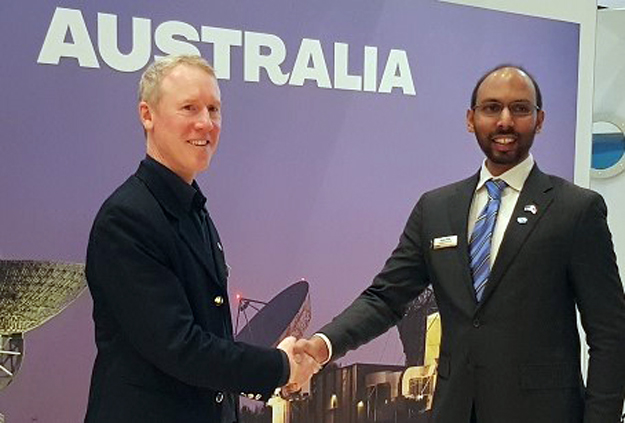
Adam Gilmour, CEO & Founder, Gilmour Space (left), and Venkat Pillay, CEO & Founder, LatConnect 60, announce the HyperSight 60 agreement at 2022 Space
Perth-based LatConnect 60 (LC60) has signed an agreement to work with Gilmour Space Technologies in Queensland to build and launch the first microsatellite of a planned high-resolution hyperspectral imaging constellation.
The satellites will be placed in 30-degree inclined orbits for frequent revisit data capture over the Earth’s equatorial and mid-latitude regions.
Company executives announced the HyperSight 60 constellation agreement at the 37th Space Symposium in Colorado Springs, USA.
“HyperSight 60 will deliver geospatial insights for mid-latitude areas at a level of detail and frequency not possible with other commercial remote sensing systems,” said Venkat Pillay, LC60 CEO and Founder.
“The addition of Gilmour Space to the LC60 team contributes significantly to the future success of our ambitious plans.”
The agreement will see Gilmour Space develop the first 100-kilogram HyperSight 60 satellite on its G-class satellite bus (G-Sat), which will be launched on Gilmour’s Eris rocket from the Bowen Orbital Spaceport in Queensland.
The first HyperSight 60 microsatellite is planned for launch in Q4 2024. The microsatellite and subsequent constellation will be owned and operated by LC60.
“This agreement would be our second G-class satellite mission on Eris, and we’re excited to be working with the pioneering team at LC60 to bring this significant capability to market,” said Gilmour Space CEO, Adam Gilmour.
Once the eight-satellite constellation is operational, an hourly revisit rate will be possible at mid-latitude locations between 30 degrees north and south in Australia, Asia, South America and Africa.
The companies say the revisit cadence, combined with the spectral bands collected in high- and medium-spatial resolution, will deliver information-rich insights for agriculture, forestry, environmental, mineral, oil and gas, climate change, maritime and defence applications.
Established in 2019, LC60 currently owns exclusive rights to 80-centimetre imagery captured over Australia, with global access from a high-resolution multispectral satellite.
LC60 is also focused on designing ‘smart’ satellites equipped with onboard AI-based computing technology. For the HyperSight 60 constellation, this will enable ‘tip-and-cue’ capabilities among satellites within the constellation and allow pre-processing of data, including radiometric and geometric correction, to occur in orbit before the data is downlinked to the ground.
“For HyperSight 60 and other planned LC60 constellations, our unique approach to onboard AI sensors, combined with advanced data fusion on the ground, will fill gaps in the insights that can be gleaned from current remote sensing systems,” said Pillay.
Stay up to date by getting stories like this delivered to your inbox.
Sign up to receive our free weekly Spatial Source newsletter.












